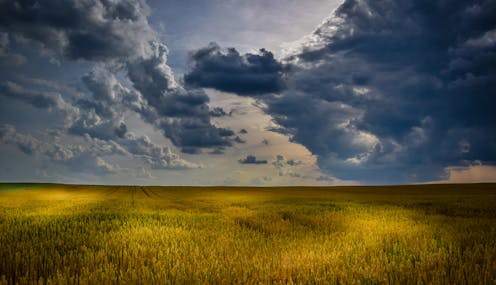
Australia has among the highest prevalence of asthma and hay fever globally. La Niña (and El Niño) will undoubtedly affect allergy sufferers.
Authors
Janet Davies
Professor, Queensland University of Technology
Alfredo Huete
Professor, Climate Change Cluster, University of Technology Sydney
Paul Beggs
Associate Professor and Environmental Health Scientist, Macquarie University
Sea-surface temperatures across the east-central equatorial Pacific cycle between episodes of La Niña (when the sea is cooler) and El Niño (when it is warmer). These complex weather patterns are likely to alter the amount of pollen in the air.
A La Niña event has been declared for the third year in a row, increasing the likelihood eastern and northern Australia will be wetter than normal. This will raise health concerns for some people due to prolific pastureland growth and more grass pollen.
Allergic rhinitis (hay fever) and asthma can be triggered by pollen from grasses, weeds or trees. Thunderstorms can also be a trigger.
Record rainfalls in regional Victoria led up to Australia's most catastrophic respiratory allergy event in November 2016, when thunderstorm asthma was linked to several thousand trips to Melbourne hospital emergency departments and ten deaths.
But our understanding of how climate change is affecting risk is limited by sparse and intermittent pollen monitoring in Australia. We'll need continuous pollen records for at least ten or 20 years to track the effects on pollen exposure.
Climate change and what to expect
Climate change appears to increase our exposure to airborne allergens such as grass pollen. Research recently showed the amount of Brisbane grass pollen measured from 2016 to 2020 was almost triple the amount monitored between 1994 and 1999.
This was linked with increasing carbon dioxide in the atmosphere, increasing temperature and lusher vegetation. The number and proportion of days with grass pollen at high and extreme levels increased significantly over time, bringing more health risks.
Highly elevated grass pollen levels were also seen during the 2021 grass pollen season up until flooding in February 2022.
It's early days, but given the declaration of another La Niña season, the upcoming grass pollen season will likely to be high again this spring and summer at least in some parts of Australia.
Pollen exposure differs significantly between locations and years. So understanding local environmental drivers is important.
Using over 20 years of satellite data and ground-based cameras to monitor the life cycle of grasses (including peak growth periods, flowering and pollination) we've shown climate change is altering the composition of grasslands with warm season grasses steadily increasing. Changes in the types of grasses growing alter allergen composition, severity, and the seasonal timing of pollen exposure. This is important for sensitisation, diagnosis and management of people with hay fever.
Keeping track of pollen
Currently, pollen monitoring is mostly undertaken by academic research groups dependent on short-term competitive funding.
Australia is several years behind Europe and Japan in adopting automated, real-time pollen monitoring. Our current manual pollen monitoring processes are labour intensive and imprecise.
For Australia to set up similar monitoring, instruments would need to learn to detect, match and count local pollens and be capable of operating over time in our diverse and often harsh external environments.
Access to real-time automated pollen monitoring across a broad coverage of sites would help with pollen forecasting. This could inform both short-term daily pollen forecasts, and early pollen season warnings.
While there are approximately 25 active pollen monitoring sites in Australia, these are mostly located in urban areas, and across Victoria. We need a wider network of monitoring sites to serve community needs and to foster better understanding of pollen sources and health implications.
A national approach to allergies
The freshly launched National Allergy Centre for Excellence will hopefully push for all Australians with pollen allergies to have access to accurate pollen information.
For now, those with allergies should keep an eye on the currently available pollen counts. If you need advice on how to better manage your pollen allergies, especially if you are at risk of seasonal allergic asthma, consult your pharmacist or discuss treatment options with your doctor.
![]()
Janet Davies has received funding in the last five years from National Health and Medical Research Council (GNT1116107), Australian Research Council (DP210100347, LP190100216, DP190100376, DP170101630), National Foundation of Medical Research Innovation with co-funding from Abionic Switzerland. QUT owns patents granted for allergy diagnostics.
Alfredo Huete receives funding from the Australian Research Council (DP210100347, DP170101630), the Terrestrial Ecosystem Research Network (TERN), the National Health and Medical Research Council (GNT1116107), and Climate-KIC Australia Fairwater Living Lab.
Paul Beggs does not work for, consult, own shares in or receive funding from any company or organisation that would benefit from this article, and has disclosed no relevant affiliations beyond their academic appointment.






